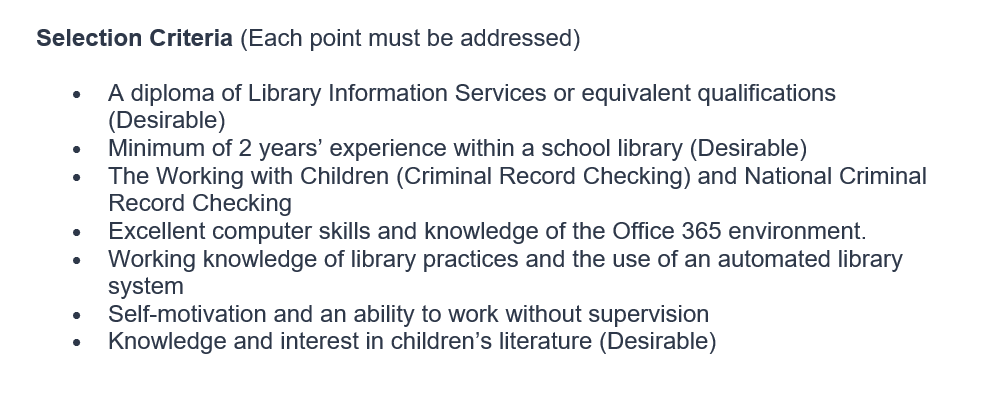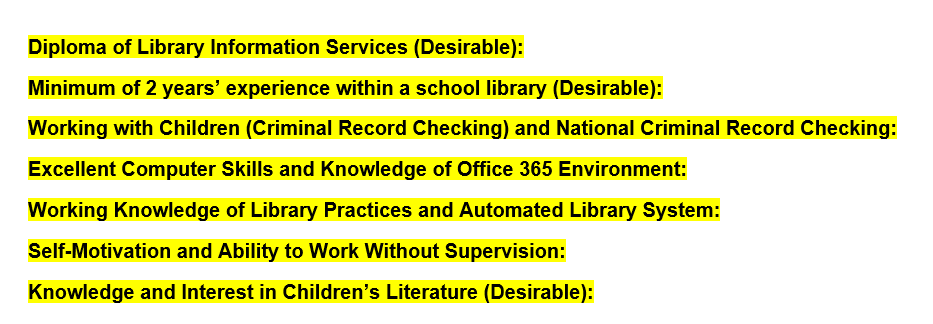

How to Write a Cover Letter Addressing Selection Criteria in 10 Steps
by Nicole Wren | Jan 29, 2024 | Writing Advice
Table of Contents
Some job applications will ask you to provide a response to selection criteria, as well as your resume or CV. These criteria are the specific skills and experience that a job requires. In many cases, the application guidelines request that the selection criteria should be responded to within a cover letter. (Sometimes, they request a response in a different format, like this APS Statement of Claims example ). Many people wonder how to write a cover letter addressing selection criteria, though (as selection criteria writers , we get asked daily!).
While your resume or CV should state that you have the relevant experience, a selection criteria response will require more detail and specific examples. As well as providing more information, selection criteria also provide a structured way to assess candidates.
The job ad might include something like this:

Let’s look at 10 things to keep in mind when addressing selection criteria in a cover letter.
1. Start Your Cover Letter in the Standard Cover Letter Format
Begin your cover letter in the standard format, with a header containing your contact information. Then, include the employer’s contact details, including their name (or a generic salutation like “Dear Hiring Manager”). Use a standard font and font size, like Arial 10-12.

2. (Opening Paragraph): Express Your Enthusiasm
Specifically state the role you are applying for. Convey your eagerness to contribute your skills and experience to the organisation. You might also like to mention the company’s values, and how your own align (tip: be specific and authentic here). If there is something else that attracts you to the organisation (such as a recent company achievement), you might like to mention it here, to show you have a good understanding of them.

3. (Body Paragraphs): List and Highlight Each Selection Criteria
List and highlight each of the selection criteria in the body of the cover letter. This will help you keep on task and ensure each selection criterion is adequately responded to (note: you should remove this at the end – see step 9).

4. (Body Paragraphs): Paraphrase Each Criterion and Your Experience
Write an introductory sentence for each criterion, paraphrasing the language and keywords used in the selection criterion.

5. (Body Paragraphs): Brainstorm Ideas for Each Criterion
Make some notes within your document, then choose your ‘best ideas’. Tip: you’ll need to be as specific as possible. Rather than saying you communicated daily with different customers in a previous role, think of a specific time you communicated with a specific customer, and how you had a positive impact.
6. (Body Paragraphs): Use the STAR Format for Each Example
The STAR format is a well-known way to structure selection criteria. It goes like this:
Situation (S): Briefly set the context by describing the situation or problem you encountered. Keep it concise to provide necessary background information. This section should make up approximately 10% of your response.
Task (T): Describe your specific role or task within the situation. Explain what was expected of you and any challenges or goals you needed to address. This section should make up around 10% of your response.
Action (A): This section should make up around 60% of your response. Describe the actions you took in detail. This is where you showcase your skills, competencies, and problem-solving abilities. Use specific examples, highlight your contributions, and explain your thought process.
Result (R): Approximately 20% of your response. Conclude by outlining the positive outcome or result of your actions. Mention any benefits to the organisation. While this is one of the smaller sections, it is one of the most important. Many candidates forget to include a strong result section.
Note, the STAR method is not necessary for yes/no criteria such as certain qualifications. For these criteria, you can simply state that you have the required qualifications.

7. (Conclusion Paragraph): Sign-off Positively
Conclude your cover letter with a short paragraph thanking the reader for their time, and welcoming the opportunity for an interview. You may like to reiterate your interest in the role.

8. Sign Off as in a Standard Cover Letter
End with a professional sign-off such as ‘Kind regards’ or ‘Yours Sincerely’, along with your full name. There is no need to sign the cover letter.

9. Remove the Highlighted Selection Criteria
Since these headings were included only as a guide for you, you should now remove them. Your introductory sentence within each paragraph will be enough to allow the reader to understand that you have addressed each one.
10. Proof-Read and Submit
Proof-read your document for any errors, including grammar and spelling. You may like to have a friend or family member complete this part for you. Another tip is to save the document as a PDF, and read through it that way (the doucmnet will look slightly different and will allow you to assess it with fresh eyes).
Cover Letter Addressing Selection Criteria Example

Frequently Asked Questions
Can you address selection criteria in a cover letter.
There are a few different formats for responding to selection criteria. Sometimes, you may be asked to respond to specific online questions related to the criteria. Sometimes, you may be asked to provide a ‘separate document’ style selection criteria response. Sometimes, you can address selection criteria in a cover letter. It is important that you thoroughly read the application guidelines to determine what is required.
How long should a cover letter addressing selection criteria be?
A cover letter addressing selection criteria should typically be between one to two pages. If the application guidelines specify a length, you should always adhere to that.
How to address selection criteria you don’t meet?
Selection criteria are sometimes deemed either essential or desirable. You should provide a response to both essential and desirable criteria, even if you don’t meet them. You should provide a summary of your most transferrable skills and experience.
Our selection criteria writers specialise in addressing selection criteria, both in cover letter and other formats.
Contact us if you need more assistance with your application.
Read our latest resume tips .

Nicole Wren
Senior Writer
Nicole is the principal resume writer at Resumes to Impress. Nicole loves writing and sharing her knowledge about all things job hunting and career guidance.
Recommended Services:

Selection Criteria Writing
- Adelaide Resume Writers
- Resume Writers Bendigo
- Resume Writing Service Brisbane
- Resume Writing Services Cairns
- Resume Writing Services Canberra
- Resume Writers Darwin
- Resume Writers Diamond Creek
- Resume Writing Services Geelong
- Resume Writing Services Gold Coast
- Hobart Resume Writers
- Resume Writers Launceston
- Resume Writers Mackay
- Melbourne Resume Writers
- Resume Writing Services Newcastle
- Resume Writers Parramatta
- Resume Writers Perth
- Resume Writers Sunshine Coast
- Resume Writers Toowoomba
- Resume Writing Services Townsville
- Resume Writers Wollongong
- Interview Coach
- LinkedIn Profile Writer
- Resume Writing Services For Veterans
- Mining Resume Writing Services
- Nurse Resume Service
- Professional IT Resume Writing Services
- EXPLORE Random Article
How to Address Key Selection Criteria in a Cover Letter
Last Updated: May 23, 2020 References
This article was co-authored by Shannon O'Brien, MA, EdM . Shannon O'Brien is the Founder and Principal Advisor of Whole U. (a career and life strategy consultancy based in Boston, MA). Through advising, workshops and e-learning Whole U. empowers people to pursue their life's work and live a balanced, purposeful life. Shannon has been ranked as the #1 Career Coach and #1 Life Coach in Boston, MA by Yelp reviewers. She has been featured on Boston.com, Boldfacers, and the UR Business Network. She received a Master's of Technology, Innovation, & Education from Harvard University. There are 12 references cited in this article, which can be found at the bottom of the page. This article has been viewed 64,027 times.
If you're applying for a job, you may be unsure how to write the cover letter or how to include key selection criteria. The key selection criteria, also known as the job requirements, are the main things your potential employer wants to see, and you must address each one in your cover letter. Start by figuring out exactly what the employer wants, and address them in the body of your letter. Follow up with a thorough proofreading, including checking your cover letter against the selection criteria.
Breaking down the Key Selection Criteria

- You could also ask the opinion of someone you know to see what they think it means.
- Some countries, such as Australia, require that all public-sector jobs provide a list of key selection criteria.

- For instance, maybe the job description states the following: "The employee will act as an intermediate between clients and the accounting department. They will take phone calls and emails from both sides, and they will be expected to communicate professionally."
- From this text, you can gather that one of the key criterion for the position is to be able to communicate on a professional level with both clients and other staff members.

Structuring Your Cover Letter to Fit the Criteria

- For instance, you might write, "My name is Jessica Roberta, and I am applying for the position of invoice coordinator, a position I heard about through a friend, Jerry Flores. I am uniquely suited for this position due to my 20+ years experience in invoicing, as well as the positions I've held as an administrative assistant."

- "I am applying for this position because I have the initiative, organizational skills, and relevant computer experience you are looking for in a candidate."
- Move on to discussing your examples of each criteria.

- Keep it concise and to the point, as you don't have much space in a cover letter.
- For instance, maybe you wrote, "training book project at the accounting firm," "burger job," and "school project." Pick the most important one.
- You could write, "I often take initiative on projects. For instance, when I realized my accounting firm didn't have a training manual, I took the initiative to create one myself."

- For instance, with good organizational skills, you might say, "I have strong organizational skills." Then go on to your example: "I reorganized the filing system for the office I worked in, and efficiency improved by 25%."
Shannon O'Brien, MA, EdM
In the middle paragraph, include five bullet points that state your experience. Make your points relevant to the job you're applying for. Keep your cover letter short and concise with about three paragraphs and bold a couple of the essential words to make them pop off the page.

- For example, you might write the following closing paragraph: "In closing, I would love to work for Invoicing Brands. My valuable experience would make me a great fit. Thank you for your time, and if you need to reach me, I am available all this week and next at 123-456-7890 or [email protected]." [9] X Research source
Providing Examples and Checking Your Work

- For instance, you might write, "In my position as an invoice manager, I was able to submit invoices on time 98% of the time. I managed that by prioritizing incoming invoices and working quickly to get them done. Then I finished the rest of the work that needed to be done in the office."

- For example, you could write, "I have shown resiliency in past positions, particularly when I worked on a training manual at XYZ Financials. It took me several months to complete the project, partly due to lack of support and printing issues, but in the end, I persevered. XYZ Financials now has a training manual to be proud of."

- For example, you might write, "At my position with XYZ Financials, I noticed staff members wasted time because of an inefficient filing system. No one wanted to shut down the area long enough to reorganize it during the week. I came up with an innovative solution, a weekend refiling extravaganza. We took one weekend to completely reorganize the area."

- For instance, maybe 3 of the criteria are "good organizational skills," "takes initiative," and "competent computer skills."
- You might write, "In my position as an office clerk, I built a database to reorganize the office filing system. Efficiency improved by 25% in the office, and my manager was impressed by my computer skills, my organizational abilities, and my initiative."
- Read through your letter. As you do, check off each of the key selection criteria you were supposed to cover. Make sure you included as many as you could in the letter.

- For example, don't say, "My organizational skills aren't great, but I am fantastic on the computer."
- Instead, say, "My computer skills are above par, as evidenced by the fact that I developed a database for our filing system in my last position."

- Make sure you have spelling and grammar check enabled on your document to help you catch mistakes.
- Ensure you've set a formal tone throughout. A formal tone is more professional than an informal tone. Don't use slang, and avoid contractions. You can use jargon specific to your field, but only if you're sure your potential employer will know it. [16] X Research source
- Once you've polished it, let another person proofread it. You can ask someone you trust professionally, for instance. If you're a student, take it to the career center if your campus has one. [17] X Research source

- When looking for flow, check that each sentence moves smoothly into the next one. For instance, you might write the following sentences: "I gained experience in computer skills at my position at XYZ Financials. Because of this position, I have experience in Microsoft Office and databases."
- They flow together because you use one sentence to transition into the next, referencing the position from the previous sentence to begin the following sentence.
Expert Q&A
You might also like.

- ↑ https://careers.vic.gov.au/vacancies/key-selection-criteria
- ↑ https://www.monash.edu/career-connect/jobs/apply/selection-criteria
- ↑ http://www.jobs.uwa.edu.au/applying/written/addressing
- ↑ http://www.uvm.edu/~career/?Page=letter.html&SM=jobsubmenu.html
- ↑ https://owl.english.purdue.edu/owl/resource/723/03/
- ↑ http://www.jobs.uwa.edu.au/applying/written/letter
- ↑ https://www.washington.edu/doit/key-elements-cover-letter
- ↑ https://owl.english.purdue.edu/owl/resource/723/01/
- ↑ http://writingcenter.unc.edu/tips-and-tools/flow/
About this article

When writing a cover letter, you can give yourself the upper-hand by addressing each job requirement. First, carefully read through the job description and and highlight the requirements, like good communication skills or the ability to work under pressure. Then, write an example of your relevant education, training, or past job experience for each requirement so you can back them up with evidence. Use the body of your cover letter to address the requirements. If you have space, write a short paragraph for each requirement and link each one to a specific example from your experience. If this would take too much space, group together similar requirements with one example. For more tips from our Career Coach co-author, including how to write a compelling intro and conclusion to your cover letter, read on! Did this summary help you? Yes No
Reader Success Stories
Hamida Begum
Jun 30, 2022
Did this article help you?

- About wikiHow
- Terms of Use
- Privacy Policy
- Do Not Sell or Share My Info
- Not Selling Info

- List of services
- Employment services
- Current vacancies
- Register for job alerts
- Become a temp
- Submit your CV
- Other services
- Payroll services
- International candidates
- Job hunting blog
- Recruitment services
- Permanent recruitment
- Executive search
- Temp recruitment
- SEEK advertising
- DISC profiling
- Outplacement
- Payroll outsourcing
- Contingency vs retained
- Recruitment blog
How to address key selection criteria in a cover letter
This article is recommended for individuals near the beginning of their careers, introduction.
Having spent a significant portion of my career in the realm of recruitment, I've come to understand the importance of job seekers ably addressing the key selection criteria of a vacancy in their cover letter.
It can truly make or break your job application. This is particularly true when an employer has noted these criteria as basics.
Allow me to share with you a step-by-step guide for taking on the key selection criteria within your cover letter.

How to address selection criteria
Understand the criteria.
As a start, read over each of the key selection criteria talked about in the job ad. Make sure you have a clear grasp of what the employer is looking for in a candidate.
Create a table or list
Sort the key selection criteria into a table or a list format. This will help you keep track of each criterion and your answer to it.
Use specific example
For each criterion, give specific examples from your past work experiences, education, or other related aspects of your background that show your skills, abilities, and experiences related to that criterion. Be sure to talk about your achievements, responsibilities, and any measurable results.
Follow the STAR method
When discussing each criterion, try using the STAR method (Situation, Task, Action, Result) to write your responses. Describe the situation or context, the task you had to carry out, the actions you took, and the results you gained. This is a clear and concise way to show your qualifications.
Highlight relevance
Make a strong link between your qualifications and the requirements of the job. Explain how your skills and experiences align with the specific criteria and how they will elevate your success in the role.
Tailor each response
Customise your answers for each criterion to match the language and terms used in the job ad. This shows your attention to detail and that you've carefully thought about the employer's needs.
While giving detailed examples is important, aim to keep your responses concise and focused. Avoid undue elaboration or extra details that could take away from the main points.
Prioritise & order
Cover the key selection criteria in the order of importance as shown in the job ad. If the criteria are not explicitly ranked, try addressing them in the order that best reveals your strengths and relevance to the role.
After drafting your responses, carefully edit your cover letter to ensure it is free of errors, typos, and grammatical mistakes. A well-written cover letter shows your professionalism and attention to detail.
Overall cover letter structure
Integrate your answers into the overall structure of your cover letter. Start with an introduction that briefly talks about the role you're applying for and why you're interested. Then address the key selection criteria, using a paragraph for each criterion. Finally, finish with a summary of your enthusiasm for the role and your availability for further discussion.
If you're looking for more in-depth help with cover letter writing, please click the button below to read my free e-book on the topic.
By following these steps, you'll be able to effectively discuss key selection criteria in your cover letter, making a great case for your suitability for the job.
Remember to customise each cover letter for the specific position you're applying to, as a tailored approach is more likely to capture the employer's attention.
For further assistance, I recommend you check out myfuture's article: How to respond to key selection criteria .

Are you looking for a job?
Now that you understand how to address key selection criteria in a cover letter, you should take a moment to check our current vacancies page .
At 11 Recruitment, we have a range of white-collar temp and perm jobs available. We're always on the lookout for top talent to place with our clients, so we encourage you to apply for any positions that are of interest.
If none of our current vacancies are right for you, you should register for job alerts . Then we’ll be able to notify you when we receive a position that matches your profile.

How to find a job in Perth

Who should you follow on LinkedIn?

Running late for an interview?

How to make conversation

How to add experience to LinkedIn

Do recruiters look at social media?

How to impress in an interview

How is the job market in Australia?

Should you email before an interview?

How to be more likeable

How to write a job application email

Is it good to include hobbies in a resume?

What to say if you’re late for an interview


How to resign

What not to wear to an interview

Are job applications confidential?

How to upskill

How to identify transferable skills

How to write a resume in Australia

What to post on LinkedIn
Click here to learn more about 11 Recruitment

What are your thoughts?
I'd love to have a conversation with you about this topic - please leave a comment below if you have any thoughts or opinions 🙂
Christian Madsen
Managing Director of 11 Recruitment
How to take a good profile picture for LinkedIn
How to network to get a job, how to tell if your new job is going well.
Session expired
Please log in again. The login page will open in a new tab. After logging in you can close it and return to this page.
- AED AFN ALL AMD ANG AUD AWG AZN BAM BBD BDT BGN BIF BND BOB BSD BWP BZD CAD CDF CHF CNY CRC CVE CZK DJF DKK DOP DZD EGP ETB EUR FJD FKP GBP GMD GNF GTQ GYD HKD HNL HUF IDR ILS INR ISK JMD JPY KES KGS KHR KMF KRW KYD KZT LAK LBP LKR MAD MDL MKD MMK MNT MOP MUR MVR MWK MYR NGN NIO NPR NZD PEN PGK PHP PKR PLN PYG QAR RON RSD RWF SAR SBD SEK SGD SHP SLL STD THB TJS TOP TTD TWD TZS UAH UGX USD UYU UZS VND VUV WST XAF XCD XOF XPF YER
- 1300 217 374

Resume and Selection Criteria Writers Give Away Free Tips
You go back to the job advertisement to upload your resume. But wait!
“Applicants must submit a cover letter and address the selection criteria in the job description,” you shockingly read.
Are you now fuming the internet to find quick hacks on how to write a cover letter and respond to selection criteria ? Have you spent hours finding the best example of a personal statement? Are you feeling overwhelmed with the selection criteria responses you’ve read online and thinking of just letting the opportunity to secure your dream job pass?
Well then, your search stops right here!
The Perfect Resume team is here to guide you and make your job application stand out! We will help you polish your application by providing you with a FREE cover letter and selection criteria samples. Read on and be on your way to landing the job of your dreams!
Cover Letter Dread: The Basics and Effortless Ways to Create One in 2022 — With Examples
A cover letter is a one-page document that aims to express your intention of securing the spot. Like a golden ticket, your cover letter is a paper that introduces you to a potential employer, aside from your resume or CV. Know to some as a motivation letter , your cover letter is submitted to explain and persuade your readers as to why you are the best candidate for the job.
Regrettably, many clients choose to pour all their efforts into perfecting their resumes only. But did you know that your cover letter can be the difference between championing your job search and being sent to the “NO” pile without any hesitation?
“How come,” you ask.
This brief document is a chance for you to showcase your communication skills, experiences, and how you can meet the potential employer’s business needs and exceed expectations. Furthermore, according to SEEK , recruiters and hiring managers still claim to read cover letters to further extract information about applicants, such as their relevant skills and tangible achievement. Zety has shared information that 45% of employers or hiring decision-makers say they expect to receive cover letters. On the other hand, 22% expect letters of interest to be addressed to the Hiring Manager. Thus, it is always a perfect idea to tailor your cover letter to each job application!
Speaking of tailoring or personalising your job search tool, Professional Resume Writers and Career Experts from The Perfect Resume put together a guide on what to include and leave out of your cover letter, including the dos and don’ts when crafting one.
Cover Letter Tip # 1: Never ever forget the must-have sections, namely:
- Contact Section. Up above in your heading section is where your contact information should be ideally placed, such as your mobile number. Why? It is the first thing a recruiter or hiring manager must-see. Without these details, it would be unlikely that you will even hear a callback or stand out from all the other applicants. Therefore, do not ever ditch this part. Additionally, make sure that your contact details are up to date and are reachable.
- Company name, date, appropriate salutation, and the name of the job you're going for. Getting this part right is very crucial. This will reveal if you dedicated enough time to research the company and the person who shall receive your cover letter. As the old saying goes, “well begun is half done.” Addressing the contact person by his or her name will provide a personalised touch and good impression to give you brownie points for an interview shortlist. However, if the information is ungraspable choose a suitable salutation.
- Attention-grabbing unique selling proposition. This is the best spot to showcase your personality and company values. If you are a person who loves making another laugh, start off with some humour. If you think that the organisation’s cause resonates with you, then it is best to acknowledge it at the beginning of your cover letter. Before you write your introduction, you must identify why do you want to apply for that specific job and why should the employer choose you over the other candidates. Doing this can help you craft a perfect cover letter introduction.
- Experiences, education, key skills, and achievements. As soon as you have your readers hooked, it is now time to shine by highlighting your standout qualities. Due to the limited time hiring managers hold within the recruitment process, it is best to keep it short but sweet! They do not have time for fluff. Hence why they use applicant tracking systems to sort candidates from being a good fit to not so suitable. So, be sure to address the employer’s wants and needs whilst incorporating your applicable past experiences, skills, and wins – both big and small!
Cover Letter Tip # 2: Familiarise yourself with mistakes to dodge, such as:
- Never start with “I am writing to apply for the XYZ position at XYZ.” Keep in mind that your cover letter is meant to make you stand out. Aside from being superfluous, beginning your cover letter with this phrase will only give the impression that you are boring or not that interested in the job. Do your research and use your cover letter as a way of communicating how you have what it takes to be the company’s next team member.
- Avoid repeating all the information on your resume . A resume is intended to state facts about your career, such as your previous roles, skills, and achievements. On the other hand, your cover letter is meant to explain how you meet the job requirements. It is an avenue for you to introduce yourself in a creative way and display your communication skills. Therefore, it is unnecessary to copy and paste the information from your resume onto your cover letter. You need to tell an interesting story.
- Eliminate the typos. According to research conducted by CareerBuilder, a trusted human capital solutions company, over 70% of hiring managers admitted that they would reject a cover letter bearing grammatical or typographical errors without a doubt. The same also goes for resumes. Therefore, make sure to proofread your document. It is also advisable to use a free online writing assistant or error-checker. Moreover, try having a trusted colleague review your cover letter. Getting a pair of fresh eyes can help catch language oversights in your relevant experience and enhance the flow of your letter of introduction without paying anything.
- Do not forget the evidence of your knowledge. It is easy to claim that you are a ‘team player’ or have all the right values for the job. However, you are not the first candidate to mention it. Often, cover letters are filled with content that applicants merely copied, such as the role title and expertise listed on the job advertisement without backing them up. Hiring managers go for a good match when they are finding candidates for jobs, someone who can communicate their relevant work experience, how they have demonstrated the required skills in their past and are a great match between the hard and soft transferable skills. In addition to that, you can write your selection criteria or professional resume in a more creative way by sprinkling in the results or achievements. Hiring managers love reading engaging resumes, especially when candidates take the time to write in a results-driven manner.
- Stay away from mentioning your expected salary. Unless you are instructed to do so, it is best to do not to mention to the recruiter or company representative how much you are expecting to receive. Indeed, good compensation in any industry is a form of motivation. However, you want to present yourself to your potential employer as a professional eager to contribute to the future of the company, not someone who is excited to just get paid.
Cover Letter Tip # 3: Create a winning and sincere final statement and call to action.
Your ending paragraph should be as captivating as your introduction. It is also great to include a call of action or a way of encouraging potential employers to contact you for further discussions on how you can be a great asset to the company. Here, you can display your enthusiasm and confidence. Lastly, if you are wondering how to end your cover letter, sign off with kind regards or yours sincerely.
Writing a Cover Letter in Australia Doesn’t Have to Be Tough
We know cover letter writing can be hard, but it doesn't have to be! If you're struggling with trying not to sound desperate or keeping your document easy to read, then fear not! Below, there are some cover letter examples for managerial and graduate roles. On the other hand, if you would like your Professional Writer from The Perfect Resume to craft a unique cover letter that suits your needs, email us at [email protected] or visit www.theperfectresume.com.au .
Finance Manager Cover Letter Example
Graduate program cover letter template, selection criteria: what is it and how do i address it in my cover letter.
The key selection criteria demonstrate how well suited you are for your dream job. Your responses are what potential employers shall use to shortlist you for a job. Unlike a cover letter, a selection criteria response is a direct, concise, and focused explanation to a situational question, for example, ‘demonstrate a time when you had to meet tight deadlines' or ‘explain a situation when you had to be flexible,’ You may address this job requirement in your cover letter. How? Through an applicant tracking systems formula:
Example Statement + Example Situation + How you overcame the challenge/problem = Criteria Response Evidence
How do you write the selection criteria for a job application.
There is no one-size-fits-all answer to this question, as the best way to answer selection criteria questions correctly depends on the specific question being asked and the job you are applying for. However, there are a few general tips that can help you to answer selection criteria questions effectively:
- Read the question carefully and make sure you understand what is being asked of you. Selection criteria can vary from employer to employer, so it’s important to read through the job ad thoroughly and understand what is required before you start writing your application. Follow the instructions: make sure you read and understand the selection criteria before starting to write your response.
- Outline how your skills, experience and qualifications match up with what is being asked for in the question. Do not be afraid of referring to previous roles. Employers want someone who can hit the ground running. Therefore, make sure that if you have experience in a similar role and the required qualifications and skills for the position, you want your next employer to know.
- Use specific examples to back up your claims and show that you have what it takes to do the job. A professional resume template will help to strengthen your argument and show that you have what it takes to do the particular job. Numbers and statistics can help add credibility to a document by providing concrete evidence to support a claim. When used effectively, they can help back up an argument with factual information. In addition, they can help to persuade your readers – and make them say, “this is the one!” The best way to use numbers in a selection criteria response is to back up general claims with specific examples. For example, rather than writing, “ I am reliable ,” you could write, “ In the past year, I have worked consistently 5 days per week and have had ZERO unaccounted days off or arrived late on any occasions .” Who would you employ if you could choose between the “I am reliable” guy or someone who has had ZERO unaccounted days off?
- Check for spelling and grammar mistakes before submitting your application. Nothing looks worse than a sloppy job application! Proofreading is so important for job seekers because it is the first impression that you make on a potential employer. If there are spelling and grammar mistakes in your application, it signals to the employer that you are not detail-oriented and that you may not be taking the job application seriously. It also shows that you may not be capable of doing the specific job if you cannot even take the time to proofread your application. By proofreading your job application, you can ensure that your application looks polished and professional.
Selection Criteria Response Example
How can the perfect resume team help.
To be successful in your job search, you need to have a compelling cover letter and give it your best shot as you try to address selection criteria. Your cover letter is the first thing that hiring managers will read, and it can help make or break an application. A well-crafted cover letter, coupled with key selection criteria responses should tell the hiring manager why they MUST have you on their team. However, if you still don't know where to start, contact The Perfect Resume today!
The Perfect Resume is here to help you get ahead in your career by providing cover letters and selection criteria responses. We offer professional writing services to make sure your job search tools are perfect before submitting them. Our team of writers is experts in crafting interview-winning documents to impress any hiring manager or recruiter. We know what employers want to see on paper and how they want their candidates presented, so let us do all the hard work.
Please send us an email at [email protected] with your resume, cover letter, and link to your dream job. We will give you tips on making prospective employers hire YOU over ALL OTHER CANDIDATES – without paying a penny!
Likewise, if you find this article helpful, don't forget to share and pass the kindness along to your fellow job seeker!
Recommended reading suggestions
- Why calling the recruiter before you apply for a job helps you land an interview?
- Here’s everything candidates need to know about an ATS
- Job Search Tips: How long do you wait for an interview call?
- Address selection criteria examples
- Create a winning resume format 2024
Would You Like a Professional Resume Writer or Career Coach to Review Your Resume or CV?
Enter your details below. we will review what you have, provide feedback & recommend the services that suit your needs.

Writing Your Key Selection Criteria Responses
Posted october 13, 2011, by sue stevens.
Many people applying for government jobs for the first time may not be aware of the importance of selection criteria responses, or how to approach them. These are a critical part of most government applications and essential to creating an outstanding application.
Even if you have a brilliant resume that shows you have excellent skills and qualifications to do the job and you’ve written an absolutely sensational cover letter tailored to the position , if you don’t address the selection criteria in a separate document that explains how well you fit each criterion, chances are you will be overlooked. Fulfilling the selection criteria to the satisfaction of the selection committee is the only way you can make it across the line to the next stage of the recruitment process – the interview.
Where to start?
The first thing you need to do is find out what the selection criteria are. You will find them either in the advertisement or on the government department’s website along with a downloadable job application kit.
Then you need to create a new document and list all the criteria, word for word, as they appear in the job application kit.
Name the document and make sure you include your own name at the top of the page. You can use a heading such as:
- Statement addressing selection criteria
- Selection criteria summary
- Responses to selection criteria
- Statement of claims, selection criteria
FYI When it comes to naming documents, all your application documentation should have your name prominently displayed and it’s best to name the electronic documents with your name, not just ‘selection_criteria.doc’. This will make it easy for the receiver to identify your document from all the others that have also been submitted.
Give examples
When answering the selection criteria think about how you meet each selection criterion and list examples of relevant skills, experience, incidents, training and personal qualities. You need to make the link between what you can do, and have done in the past, and how it relates to the job. If you don’t have any actual work experience, use other relevant experience such as something you have done at university, for a voluntary organisation or a club to illustrate your capacity to undertake the work required.
In every answer to the criteria, you need to demonstrate that you have developed and practised these skills in your past experience/s. It’s not enough to just state that you can do ‘it’.
Use keywords
Part of the trick of responding to selection criteria is identifying and understanding the keywords in each criterion and incorporating these into your response. These subtle differences and the way you word your response could be what sets you apart from the other applicants.
Know the difference between phrases such as ‘ability to’ (means having the skills), ‘knowledge of’ (familiarity gained from actual experience) and ‘understanding of’ (fully comprehend the matter). Incorporate your understanding of these terms into your response and you’re on the right track to submitting an outstanding statement.
Choose the right words
When writing a selection criterion response, find one excellent example from your past and demonstrate what and how you achieved a good outcome. Make sure that you use strong action words such as ‘demonstrated’, ‘reviewed’, ‘developed’, ‘initiated’ or ‘negotiated’ rather than less powerful words such as ‘involved in’ or ‘assisted’.
Always give examples and avoid unsubstantiated claims. You can use bullet points if there is a list of points you are making.
Address all the parts
More often than not, selection criteria will consist of several parts and are sometimes qualified as either essential (must-have skills and experience) or desirable (good to have and improve your chances of being highly regarded).
It is tempting to write a broad response focusing on just one part of the criterion and hope this will get you through. But if you want to hit the selection criteria nail on the head and guarantee yourself an interview, then this isn’t good enough.
For example, ‘Ability to contribute ideas and demonstrate initiative and flexibility’ actually has three components – ability to contribute ideas, demonstrate initiative and demonstrate flexibility. In order to respond to this correctly it is vital that you address all three of these skills, making sure to include the keywords in your response.
STAR approach
As mentioned above, the key to responding to selection criteria well is to address all parts of the criterion, to include the keywords and give specific examples. Many well-written statements follow what is known as the STAR method of response: Situation, Task, Action, Result.
The following example response is broken up into the STAR components, with each section labelled. This is for your benefit – don’t label the sections in your final statement!
Ability to apply academic knowledge and concepts to practical situations
Another acceptable way of answering selection criteria is SAO: Situation, Action, Outcome. Whether you choose STAR or SAO, it is important that you show how you can meet each criterion.
The final touches
Some government departments and agencies do not want any more than three paragraphs per criterion (or about 250 words); others do not have any limit. As a general rule, try to be as concise as possible and at the maximum, write no more than one A4 page per criterion.
Once you have completed your statement of claims in relation to selection criteria, check over your responses and make sure there are no typographical errors and that the sentences read well.
Finally, make sure that the formatting of your selection criteria document matches the accompanying resume (or CV), cover letter and any other documentation you are submitting. By having a consistent formatting style with fonts and font sizes, your application will present as a cohesive whole. This alone shows that you have taken considerable care and attention to detail.
Get the selection criteria right and you’re on your way to an interview – and one step closer to the job!
If you’re looking for inspiration, take a look at our sample key selection criteria responses .
Sue stevens.

Thanks for your enquiry
Good luck with your studies.
Two-Page Cover Letter Addressing the Statement of Duties
- Post author: theresumewriters
- Post published: January 12, 2019
- Post category: Australian Public Service / Cover Letters / Selection Criteria
- Post comments: 2 Comments
Two-page cover letter addressing the statement of duties/selection criteria
The format which has all but wholly replaced traditional selection criteria.
By Jacquie Liversidge
Navigate to:
How to write a 2-page cover letter that addresses government requirements.
More and more, there are content length limitations placed on selection criteria responses, and the majority of the time, these are two pages, or roughly 1500 words.
This has been implemented by the Commonwealth and most state governments in response to enormous selection criteria responses being submitted for government roles, jam packed with empty content which doesn’t demonstrate an applicant’s capabilities.
When applicants write their selection criteria, there is a tendency to fill the selection criteria with ‘padding’, or useless material, to increase the length with the idea that more is better.
Length certainly isn’t everything. When it comes to selection criteria, you want to get your material out quickly and efficiently with the most impact and the lowest word count.
You want to use your audience’s limited time well.
And this is where directions for a two-page cover letter come in to play.
How to spot it when it applies
Either on the applicant guide or the initial link to the prospective role, there will be a section titled ‘How to Apply’.
Read this section carefully and make sure you are aware of what the directions are.
How to interpret the position description
Click on the position description and look over what is listed therein.
On the position description for most government applications, you will usually find the following sections titled exactly like this, or very similarly:
- Position Objective
- Role context
- Responsibility
- Knowledge, Skills and Experience (Selection Criteria – in relation to the major duties)
Selection criteria can also be called Essential Requirements, Role Specific Requirements, Success Criteria. Nonetheless, the easiest way to spot these questions are by looking for dot-pointed content that looks a bit like this:
eg. – Demonstrated ability to provide consumer-centred care
– Exceptional communication skills and conflict resolution skills.
– Proven report writing capabilities.
Once we have a good idea of the important background, context, and scope, and we’ve found the selection criteria we need to respond to, we can start on our content. Here’s a bunch of over ten detailed selection criteria examples to get you started.
Here’s an example of a two-page cover letter addressing the required sections Queensland Government. Increasingly, these questions are values based, as they were below :
Two-page statement example
The structure, introduction: why you’re applying, what you’re offering, and why you’d be a great fit, the selection criteria question restated which is entirely optional. it’s also appropriate to skip this part, and move on to the next., our response, with the topic sentence (first sentence) repeating the question. (do this for all questions), a call to action (cta) statement ending the cover letter, professional sign-off, tips, tricks, and other information to note:.
If it’s a two-page cover letter for a government role, and it says nothing about addressing the requirements of the role, but there is selection criteria present, you do still need to address the selection criteria.
Traditionally, where the position description/advertisement asks for responses to the selection criteria, you would develop your questions and title them with the question. This approach is exactly the same, but incorporates the cover letter element of an introduction statement, and it simply does not contain the selection criteria within the documents as headings.
The point of the exercise is demonstrate your capability to perform in the role via examples of your ability to do that prior. The only part of the story which demonstrates your capability, are the actions that you took.
Focus on the inner content
Save your space for the real content that will get you selected by keeping your introduction short and to the point, and your call-to-action statement at the end within 2 sentences.
Introduction example:
I wish to submit my application for the position of Communications Officer as listed on the Tasmanian Government jobs website. I am confident I would be an ideal candidate for the position given my extensive experience within the corporate communications environment, my proven successes in a variety of roles and my strong interest in supporting strategic objectives through strong external communication.
Call-to-Action example:
Thank you for taking the time to consider my application for the role of Communications Officer. Please do not hesitate to contact me on the details contained herein for further information or to arrange an interview.
Keep your content focused on the selection criteria. Keep it concise and make every word count.
And that’s all folks.
Happy hunting!
You Might Also Like
Applying for australian government jobs – state by state, senior executive service (ses) pitch writing, el1 selection criteria and pitch writing, this post has 2 comments.
Pingback: Applying for Australian Government Jobs - State by State | The Resume Writers
Pingback: How to use STAR in selection criteria & cover letters | The Resume Writers
Leave a Reply Cancel reply
This site uses Akismet to reduce spam. Learn how your comment data is processed .
Get a Quote
Book a 15 minute call/Teams meeting
The Resume Writers acknowledges the traditional custodians of the lands on which our business operates. We pay our respects to ancestors and Elders, past and present.
- Book a Discovery Call
- Resume Writing
- Government Selection Criteria
- Get In Contact
- How It Works
- Terms, Conditions and Privacy Policy
- 1300 272 477
- 5/18 Elizabeth Street Hobart TAS 7000
- 903/50 Clarence St, Sydney NSW 2000
- Level 8, 805/220 Collins St, Melbourne VIC 3000
- 9/204 Alice St, Brisbane QLD 4000
- 202/37 Barrack St, Perth WA 6000
- 3/55 Gawler Place, Adelaide SA 5000
- [email protected]
- Monday - Friday 9AM - 5PM
© All rights reserved
Discover more from The Resume Writers
Subscribe now to keep reading and get access to the full archive.
Type your email…
Continue reading
How to write a cover letter
A cover letter is your first introduction to a potential employer, so it needs to show that you’re a suitable candidate.
A cover letter is an important document that introduces your resume to potential employers and highlights your suitability for the role. The effort you put into a well-tailored cover letter can go a long way to convincing a prospective employer that you’re a highly motivated candidate, and will help you to stand out in the application process.
The purpose of a cover letter
A common misconception is that a cover letter is simply a reiteration of the information on your resume . However, the structure and purpose of each document is different. While your resume is a polished summary of what you’re offering, your cover letter is a professional letter that introduces your application and reasons for applying for the job, linking the relevant skills and experience on your resume to the job requirements and organisation.
An effective cover letter demonstrates to a potential employer:
1. A strong interest in the role and the organisation
Employers want to hire candidates who are genuinely interested in their job, not just any job. Do your research and explain why the organisation appeals to you.
2. How you meet the selection criteria
Focus on the skills and attributes the employer has mentioned in the job advertisement. In your responses to selection criteria , offer short examples of how you have developed or utilised your skills for a positive outcome.
3. Excellent written communication skills
A cover letter should be written using professional language and structured paragraphs. Proofread your letter for spelling and grammatical errors.
Cover letter tips
The primary emphasis should be on what you could contribute to the organisation, rather than on what you expect from the organisation. For a cover letter to be effective:
- Keep it to one A4 page.
- Ensure your name, address, phone number and email address are included on the letter.
- Include the title, name and job title of addressee (spelled correctly), as well as the organisation’s name and address on the letter. Only use “Dear Sir or Madam” if you can’t find the hiring manager’s name.
- Be clear about which job you are applying for by referring to the job title or vacancy number listed in the job advertisement.
- Use a professional font (eg, Arial, Calibri – nothing too ornate or difficult to read) and keep your formatting consistent with your other application documents.
- Indent or leave a space between each paragraph.
- Send your cover letter as an attachment, do not type it into the body of the email.
- Do not send the same generic letter to every employer. It must be closely tailored to the job and the organisation.
- Keep the information in your resume and cover letter consistent – your cover letter should not introduce experience that you have not listed in your resume.
Use our cover letter template
Need more cover letter tips, how to write a resume.
A clear, tailored and professional resume is essential for any job application. It should aim to convince an employer that your qualifications, work experience and skillset make you a strong match for the job.
Addressing selection criteria
Selection criteria are the skills, knowledge, and experience required to successfully do the job.
Move forward, get ahead.™
- Jun 27, 2023
Demystifying the Difference: Cover Letter vs. Selection Criteria
When it comes to applying for a job or a position, it's essential to understand the various components of the application process..
Two common requirements that often confuse applicants are the cover letter and selection criteria . While both play crucial roles in showcasing your qualifications and suitability for a job, they serve distinct purposes.
In this article, we will explore the key differences between a cover letter and selection criteria , providing clarity and guidance to help you craft compelling application materials.

Cover Letter: Introducing Yourself and Showcasing Your Fit
A cover letter is a personalized letter addressed to the hiring manager or employer, accompanying your resume. Its primary purpose is to introduce yourself, express your interest in the position, and highlight why you are a suitable candidate. Here are some key characteristics of a cover letter:
a. Introduction and Salutation: Start with a formal greeting, addressing the hiring manager by name if possible. Introduce yourself and express your interest in the position.
b. Personalization and Customization: Tailor your cover letter to each specific job application. Research the company and the role to understand their needs and align your skills and experiences accordingly.
c. Concise Overview of Your Background: Summarize your relevant qualifications, experiences, and achievements. Focus on the most compelling aspects that directly relate to the job requirements.
d. Showcasing Fit and Passion: Demonstrate your understanding of the company's values, goals, and challenges. Explain how your skills, knowledge, and enthusiasm make you a strong fit for the role.
e. Closing and Call to Action: Express gratitude for considering your application and include a polite request for an interview or further discussion. Provide your contact information.
Selection Criteria: Addressing Specific Job Requirements
Selection criteria, also known as key selection criteria or KSC, are a set of specific requirements outlined by the employer or hiring organization.
They serve as guidelines for assessing applicants' suitability for the position. Selection criteria are usually presented as a list of skills, qualifications, experiences, or attributes that candidates must address in their application.
Here's what you need to know about selection criteria:
a. Detailed Responses: Each selection criterion requires a detailed response addressing how you meet the specific requirement. Use examples, experiences, and achievements to support your claims.
b. STAR Method: Structure your responses using the Situation, Task, Action, Result (STAR) method. Describe the situation or problem, the task or objective, the actions you took, and the results or outcomes achieved.
c. Clear and Concise Writing: Ensure your responses are well-structured, easy to read, and directly address each criterion. Use specific keywords from the criteria and provide evidence of your skills and experiences.
d. Demonstrating Competencies: Focus on showcasing your relevant competencies, such as teamwork, leadership, problem-solving, communication, and adaptability. Align your experiences with the desired criteria.
e. Compliance with Instructions: Pay close attention to any specific instructions provided by the employer regarding word limits, formatting, or submission methods. Failure to comply may result in disqualification.
Differentiating Cover Letter and Selection Criteria
The primary distinction between a cover letter and selection criteria lies in their purpose and focus.
A cover letter allows you to introduce yourself, demonstrate your fit for the position, and express your enthusiasm. It provides an opportunity to showcase your overall qualifications and present a persuasive narrative of your candidacy.
On the other hand, selection criteria require you to address specific job requirements outlined by the employer. It demands more detailed and structured responses, highlighting your skills and experiences relevant to each criterion.
Selection criteria help employers assess your suitability based on specific qualifications and competencies.
Understanding the difference between a cover letter and selection criteria is crucial when applying for jobs.
A cover letter serves as your introduction and showcases your overall fit for the position, while selection criteria require detailed responses addressing specific job requirements.
By mastering these two components of the application process, you can present a comprehensive and compelling case for your candidacy, increasing your chances of securing the desired position.

IMAGES
VIDEO
COMMENTS
Here are a few steps on how to address key selection criteria in a cover letter: 1. Review the job description. Companies often include required selection criteria in the job description. All public sector roles include these criteria. As you review the job description, find the keywords to include in the body of your cover letter. This can ...
Table of Contents. How to Write a Cover Letter Addressing Selection Criteria in 10 Steps. 1. Start Your Cover Letter in the Standard Cover Letter Format. 2. (Opening Paragraph): Express Your Enthusiasm. 3. (Body Paragraphs): List and Highlight Each Selection Criteria. 4.
Make your points relevant to the job you're applying for. Keep your cover letter short and concise with about three paragraphs and bold a couple of the essential words to make them pop off the page. 5. Close the letter by restating your interest. In the final paragraph, say how much you'd like the position again.
Integrate your answers into the overall structure of your cover letter. Start with an introduction that briefly talks about the role you're applying for and why you're interested. Then address the key selection criteria, using a paragraph for each criterion. Finally, finish with a summary of your enthusiasm for the role and your availability ...
Speaking of tailoring or personalising your job search tool, Professional Resume Writers and Career Experts from The Perfect Resume put together a guide on what to include and leave out of your cover letter, including the dos and don'ts when crafting one. Cover Letter Tip # 1: Never ever forget the must-have sections, namely: Contact Section.
Cover letter example Here is an example of a standard cover letter that you can use as a guide when applying for jobs: Joey Platt Austin, TX 555-180-9907 Joey.Platt@E_mail.com July 6, 2020 Dear Ms. Beasley, I am writing to apply for the hotel manager position at Palladium Suites in Austin, Texas. I have several years of experience in the hospitality and service industry, including managerial ...
How to address selection criteria. To address selection criteria in a one-page cover letter, see our cover letter tips and template.. Your responses to the selection criteria in a statement of claims or online application form will be more detailed and contain enough evidence to convince the employer that you meet the job criteria. A simple one- or two-line answer will rarely be sufficient.
As mentioned above, the key to responding to selection criteria well is to address all parts of the criterion, to include the keywords and give specific examples. Many well-written statements follow what is known as the STAR method of response: Situation, Task, Action, Result. The following example response is broken up into the STAR components ...
Pick out the most important requirements from the person specification and evidence your ability to meet them. - 100 - 250 words in total. Closing paragraph: Include a brief summary of why you are the ideal candidate for the role and include a strong call to action. - Approx 25- 50 words.
Middle paragraph (s) Closing paragraph. Letter ending and signature. Your cover letter should be one page long and use a simple, professional font, such as Arial or Helvetica, 10 to 12 points in size. Your letter should be left-aligned with single spacing and one-inch margins. Show Transcript.
In the following post, I will explain how to appropriately incorporate your responses to the key selection within your cover letter.Make sure that your cover letter has an introduction and a conclusion. Write up the cover letter as you normally would for any other job. Generally speaking, most cover letters are just a page long. However,
How to write a 2-page cover letter that addresses government requirements. More and more, there are content length limitations placed on selection criteria responses, and the majority of the time, these are two pages, or roughly 1500 words. This has been implemented by the Commonwealth and most state governments in response to enormous ...
Keep your cover letter to 1 x A4 page or approximately 300 words. Use a professional font that is easy to read. Use strong action words e.g.: "manage, "organise", "deliver". Include all your contact details. Always do a final spell check and proofread. View all.
Paragraph 3: this is where you provide evidence as to how your qualifications, skills and experience meet the selection criteria for the position. You can draw evidence from a range of experiences if relevant, including academic studies, extracurricular activities, placements, volunteer roles and paid employment history, including casual work.
2. Cover letters that address the selection criteria: These can be anywhere from 2 to 4 pages in length depending upon the job listing requirements and require you to address all the selection criteria within the cover letter. By understanding the different types of cover letters, you are able to pick the most suitable letter that will help you to
The following is general advice on how to draft a professional job application cover letter. A cover letter must highlight your key achievements against the specific selection criteria and must be tailored to the particular job or position you are applying for. A cover letter is often required in the job application process. However, if in ...
However, you are expected to demonstrate in your written application (resume and covering letter) that your capabilities fulfill the requirements of the position, including the selection criteria. If you choose to address selection criteria in your written application, guidelines on how to do so are outlined below. Back to top. Addressing the ...
Essential criteria will usually appear near the words 'essential', 'must have' or similar. Preferred criteria will usually appear near the words 'preferred,' 'desirable' or similar. Look for the names of any degrees, diplomas or certificates, skills and experiences mentioned in the job description. 2. Research the employer.
3 Use the STAR method. The third step to writing a cover letter for a government job is to use the STAR method to address the selection criteria and key requirements. The STAR method stands for ...
For a cover letter to be effective: Keep it to one A4 page. Ensure your name, address, phone number and email address are included on the letter. Include the title, name and job title of addressee (spelled correctly), as well as the organisation's name and address on the letter. Only use "Dear Sir or Madam" if you can't find the hiring ...
Cover Letter Guide ... knowledge or qualifications satisfy this criteria. Including selection criteria in the application process assists the Selection Panel in assessing all applicants fairly and consistently. 2 Applicants are also benefited by the selection criteria, as it gives you a better understanding of what the job ...
What to include. It is recommended that you include the following information in your covering letter: Your address. Date of your application. Title and reference number of the position for which you're applying. Indication of what is included in your application; for example, résumé, statement addressing the selection criteria (optional ...
The primary distinction between a cover letter and selection criteria lies in their purpose and focus. A cover letter allows you to introduce yourself, demonstrate your fit for the position, and express your enthusiasm. It provides an opportunity to showcase your overall qualifications and present a persuasive narrative of your candidacy.